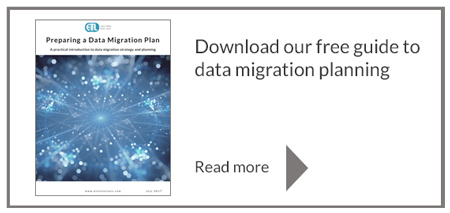How to plan a data migration project
Data migration is a complex process, requiring a robust methodology. The process in this data migration planning guide will help to minimise the risks inherent in a data migration project. It also dovetails neatly into the structure and requirements of most organisations.
1. Scope the project thoroughly
At the start of the project, scoping identifies potential issues that may occur later on. This enables the migration team to plan for any risks.
The aim of scoping is to thoroughly review the project before it starts. Our consultants divide the review into two parts: the project’s structure and its technical aspects.
The project review should evaluate the following areas:
- Are the deadlines and objectives clearly defined?
- Is the budget large enough?
- Have the requirements of all potential stakeholders been included in the plan?
- Are there communication plans in place, and do they include all stakeholders?
- Are there enough team members and do they have the right skills? If they’re consultants, will they be available for the duration of the project?
The technical review is used to check the quality and appropriateness of:
- The proposed migration methodology
- The data security plan
- The technical features of the proposed data migration tool
- The software’s fit with the skills of the people working on the project.
- The structure, volume and quality of the data.

2. Choose a robust data migration methodology
A clear methodology is an essential part of a successful data migration. Most companies who provide data migration services have their own methodology; ours consists of the pre-migration scoping mentioned above, followed by project assessments and a core migration process. Whatever its source, the methodology should include:
- Extract design: how the data is extracted, held and verified
- Migration design: how data is transformed into the target structure
- Mapping rules: the details of the migration
- Test overview: tools, reporting, structure and constraints
- Unit test: unit test specification
- Integration test: integration test specification
- Recovery plan: recovery options for each stage of the migration
- Go live plan: actions required to go live.
Read our example of a data migration methodology: click here.
There are a number of phases of data preparation:
- Landscape analysis checks how each system works and how the data within each system is structured
- Data assurance validates the data identified in the landscape analysis and ensures that all data is fit for purpose
- Data profiling provides a check of data quality and ensures that any historical data is suitable for the new requirements of the organisation
- Data quality definitions are used during the profiling phase to identify whether or not the data is of the correct standard and format
- A retirement plan should be used to define the data no longer required
- Data verification, which is then followed by data cleansing, checks that the data is available, accessible, complete and in the correct format
- Data impact analysis ensures that data cleansing does not have a knock-on effect on other elements within the source and target systems.
4. Ensure data security
Data security has become a high-profile issue, particularly with the advent of the GDPR. The migration team should create data security plans early on and embed them in the data migration plan. Areas to consider include:
- How to ensure secure data transfer
- How to create secure server access
- How to ensure secure data access
- The number of permissions required to transfer data
- Clearance and vetting of personnel, including outside consultants
- The training or information sessions required by personnel
- Vetting of the software that will be used for the migration
- Protocols for the use of email and portable storage devices.
5. Encourage business engagement
The backing of senior business leaders will improve the chances of a data migration project going smoothly and ensure that the team has the necessary resources. The key is to communicate that the purpose of the migration is to make the overall business more effective and efficient.
The project will benefit if:
- It is aligned with business priorities, particularly profit
- Expectations are managed, both in terms of timescales and the input required of senior managers
- Specific business issues are linked to it
- Best practices are demonstrated and, if possible, accreditations or management standards
- Quick wins are demonstrated as well as long-term gains.
These activities all incorporate data migration best practice, with the additional benefit of making the data migration process a little more straightforward. Read more about the planning process in our free data migration planning guide.


